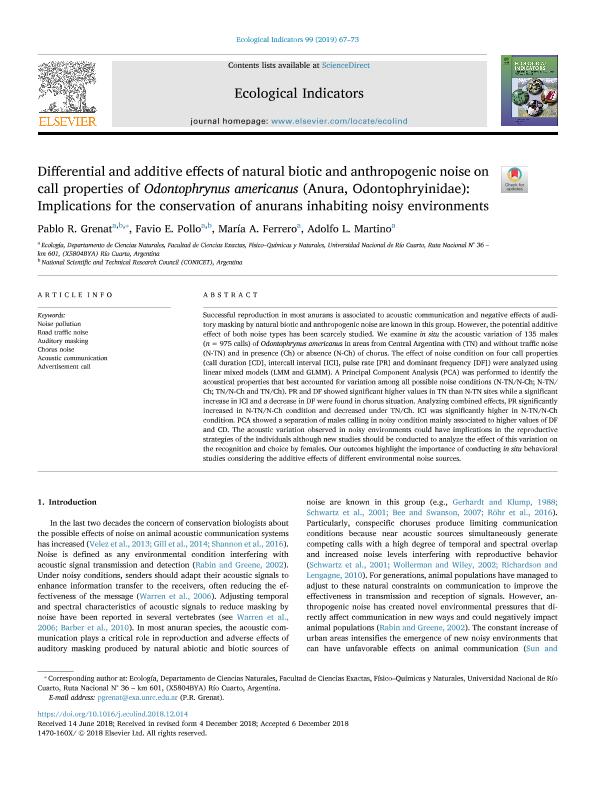Mostrar el registro sencillo del ítem
dc.contributor.author
Grenat, Pablo Raúl

dc.contributor.author
Pollo, Favio Ezequiel

dc.contributor.author
Ferrero, María A.
dc.contributor.author
Martino, Adolfo Ludovico

dc.date.available
2020-08-27T14:38:15Z
dc.date.issued
2019-04
dc.identifier.citation
Grenat, Pablo Raúl; Pollo, Favio Ezequiel; Ferrero, María A.; Martino, Adolfo Ludovico; Differential and additive effects of natural biotic and anthropogenic noise on call properties of Odontophrynus americanus (Anura, Odontophryinidae): Implications for the conservation of anurans inhabiting noisy environments; Elsevier Science; Ecological Indicators; 99; 4-2019; 67-73
dc.identifier.issn
1470-160X
dc.identifier.uri
http://hdl.handle.net/11336/112539
dc.description.abstract
Successful reproduction in most anurans is associated to acoustic communication and negative effects of auditory masking by natural biotic and anthropogenic noise are known in this group. However, the potential additive effect of both noise types has been scarcely studied. We examine in situ the acoustic variation of 135 males (n = 975 calls) of Odontophrynus americanus in areas from Central Argentina with (TN) and without traffic noise (N-TN) and in presence (Ch) or absence (N-Ch) of chorus. The effect of noise condition on four call properties (call duration [CD], intercall interval [ICI], pulse rate [PR] and dominant frequency [DF]) were analyzed using linear mixed models (LMM and GLMM). A Principal Component Analysis (PCA) was performed to identify the acoustical properties that best accounted for variation among all possible noise conditions (N-TN/N-Ch; N-TN/Ch; TN/N-Ch and TN/Ch). PR and DF showed significant higher values in TN than N-TN sites while a significant increase in ICI and a decrease in DF were found in chorus situation. Analyzing combined effects, PR significantly increased in N-TN/N-Ch condition and decreased under TN/Ch. ICI was significantly higher in N-TN/N-Ch condition. PCA showed a separation of males calling in noisy condition mainly associated to higher values of DF and CD. The acoustic variation observed in noisy environments could have implications in the reproductive strategies of the individuals although new studies should be conducted to analyze the effect of this variation on the recognition and choice by females. Our outcomes highlight the importance of conducting in situ behavioral studies considering the additive effects of different environmental noise sources.
dc.format
application/pdf
dc.language.iso
eng
dc.publisher
Elsevier Science

dc.rights
info:eu-repo/semantics/openAccess
dc.rights.uri
https://creativecommons.org/licenses/by-nc-nd/2.5/ar/
dc.subject
ACOUSTIC COMMUNICATION
dc.subject
ADVERTISEMENT CALL
dc.subject
AUDITORY MASKING
dc.subject
CHORUS NOISE
dc.subject
NOISE POLLUTION
dc.subject
ROAD TRAFFIC NOISE
dc.subject.classification
Conservación de la Biodiversidad

dc.subject.classification
Ciencias Biológicas

dc.subject.classification
CIENCIAS NATURALES Y EXACTAS

dc.title
Differential and additive effects of natural biotic and anthropogenic noise on call properties of Odontophrynus americanus (Anura, Odontophryinidae): Implications for the conservation of anurans inhabiting noisy environments
dc.type
info:eu-repo/semantics/article
dc.type
info:ar-repo/semantics/artículo
dc.type
info:eu-repo/semantics/publishedVersion
dc.date.updated
2020-08-20T20:26:36Z
dc.journal.volume
99
dc.journal.pagination
67-73
dc.journal.pais
Países Bajos

dc.journal.ciudad
Amsterdam
dc.description.fil
Fil: Grenat, Pablo Raúl. Universidad Nacional de Rio Cuarto. Facultad de Cs.exactas Fisicoquimicas y Naturales. Instituto de Ciencias de la Tierra, Biodiversidad y Ambiente. - Consejo Nacional de Investigaciones Cientificas y Tecnicas. Centro Cientifico Tecnologico Conicet - Cordoba. Instituto de Ciencias de la Tierra, Biodiversidad y Ambiente.; Argentina
dc.description.fil
Fil: Pollo, Favio Ezequiel. Universidad Nacional de Río Cuarto. Facultad de Ciencias Exactas Fisicoquímicas y Naturales. Departamento de Ciencias Naturales. Cátedra de Ecología; Argentina. Consejo Nacional de Investigaciones Científicas y Técnicas; Argentina
dc.description.fil
Fil: Ferrero, María A.. Universidad Nacional de Río Cuarto. Facultad de Ciencias Exactas Fisicoquímicas y Naturales. Departamento de Ciencias Naturales. Cátedra de Ecología; Argentina
dc.description.fil
Fil: Martino, Adolfo Ludovico. Universidad Nacional de Río Cuarto. Facultad de Ciencias Exactas Fisicoquímicas y Naturales. Departamento de Ciencias Naturales. Cátedra de Ecología; Argentina
dc.journal.title
Ecological Indicators

dc.relation.alternativeid
info:eu-repo/semantics/altIdentifier/url/https://linkinghub.elsevier.com/retrieve/pii/S1470160X18309464
dc.relation.alternativeid
info:eu-repo/semantics/altIdentifier/doi/https://doi.org/10.1016/j.ecolind.2018.12.014
Archivos asociados
